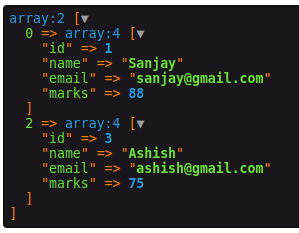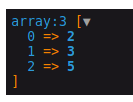Inside this article we will see the use of filter() method in laravel 9 collections. Article contains a very classified information about the basic concept of Laravel 9 Collection filter().
We will see the concept of filter item into laravel collection. We will filter data into single dimensional array, multi dimensional array.
The Illuminate\Support\Collection class provides a fluent, convenient wrapper for working with arrays of data. For example, check out the following code. We’ll use the collect helper to create a new collection instance from the array.
As mentioned above, the collect helper returns a new Illuminate\Support\Collection instance for the given array.
So, creating a collection is as simple as:
$collection = collect([1, 2, 3]);Learn More –
- Laravel 9 Collection first() and firstWhere() Methods
- Laravel 9 Collection Get First and Last Item Tutorial
- Laravel 9 Collection Get Unique Values Tutorial
- Laravel 9 Collection push() and put() Methods Tutorial
Let’s get started.
Laravel Installation
Open terminal and run this command to create a laravel project.
composer create-project laravel/laravel myblogIt will create a project folder with name myblog inside your local system.
To start the development server of laravel –
php artisan serveURL: http://127.0.0.1:8000
Assuming laravel already installed inside your system.
Collection – filter() Method
We will see how to use filter() into collection.
Suppose we have SiteController.php a controller file inside /app/Http/Controllers folder.
Code Example #1
Laravel Collection filter() with multi dimensional array.
<?php
namespace App\Http\Controllers;
use Illuminate\Http\Request;
class SiteController extends Controller
{
public function index()
{
$students = collect([
["id" => 1, "name" => "Sanjay", "email" => "sanjay@gmail.com", "marks" => 88],
["id" => 2, "name" => "Vijay", "email" => "vijay@gmail.com", "marks" => 70],
["id" => 3, "name" => "Ashish", "email" => "ashish@gmail.com", "marks" => 75]
]);
$passed = $students->filter(function ($value, $key) {
return data_get($value, 'marks') > 70;
});
$passed = $passed->all();
dd($passed);
}
}
Concept
$passed = $students->filter(function ($value, $key) {
return data_get($value, 'marks') > 70;
});Output

Code Example #2
Laravel Collection filter() with single dimensional array.
<?php
namespace App\Http\Controllers;
use Illuminate\Http\Request;
class SiteController extends Controller
{
public function index()
{
$data = collect([2, 3, 5, null, false, '', 0, []]);
$data = $data->filter()->all();
dd($data);
}
}
In this case it will remove the false values from array

We hope this article helped you to Laravel 9 Collection filter() Method Tutorial in a very detailed way.
Online Web Tutor invites you to try Skillshike! Learn CakePHP, Laravel, CodeIgniter, Node Js, MySQL, Authentication, RESTful Web Services, etc into a depth level. Master the Coding Skills to Become an Expert in PHP Web Development. So, Search your favourite course and enroll now.
If you liked this article, then please subscribe to our YouTube Channel for PHP & it’s framework, WordPress, Node Js video tutorials. You can also find us on Twitter and Facebook.
